Dassault Mirage III
| Mirage III | |
|---|---|
| | |
| Royal Australian Air Force Mirage IIIO(F) (fighter) from 2 Operational Conversion Unit | |
| Role | Interceptor aircraft |
| Manufacturer | Dassault Aviation |
| First flight | 17 November 1956 |
| Introduction | 1961 |
| Status | In service |
| Primary users | French Air Force (historical) Pakistan Air Force Royal Australian Air Force (historical) Israeli Air Force (historical) South African Air Force (historical) |
| Number built | 1,422 |
| Variants | Dassault Mirage IIIV Dassault Mirage 5 Atlas Cheetah |
The Dassault Mirage III (French pronunciation: [miʁaʒ]) is a family of single-seat, single-engine, fighter aircraft produced by Dassault Aviation for the French Air Force and widely exported. Prominent operators included Argentina, Australia, South Africa, Pakistan and Israel, as well as a number of non-aligned nations.[1] Though an older design, the second generation fighter is a fairly maneuverable aircraft and an effective opponent in close range dogfighting.[2] In French service it was armed with air-to-ground ordnance or R.550 Magic air-to-air missiles.[1]
The versatility of the design enabled production of trainer, reconnaissance and ground-attack versions as well as the Dassault Mirage 5, Dassault Mirage IIIV and Atlas Cheetah variants.[3] A Mirage III was the first Western European combat aircraft to exceed Mach 2 in horizontal flight.[4]
Development
Origins
The Mirage III family grew out of French government studies begun in 1952 which led in early 1953 to a specification for a lightweight, all-weather interceptor capable of climbing to 18,000 meters (59,100 ft) in six minutes and able to reach Mach 1.3 in level flight.[4] Dassault's response to the specification was the MD.550 Mystère-Delta, a diminutive and sleek jet that was to be powered by two 9.61 kN (2,160 lbf) Armstrong Siddeley MD30R Viper afterburning turbojets, with a SEPR 66 liquid-fuel rocket engine to provide boost thrust of 4.7 kN (1,100 lbf). The aircraft had a tailless delta configuration, with 5% thickness (ratio of airfoil thickness to length) and 60° sweep.

The tailless delta configuration has a number of limitations. The lack of a horizontal stabilizer meant flaps cannot be used, resulting in a long takeoff run and a high landing speed. The delta wing itself limits maneuverability; and suffers from buffeting at low altitude, due to the large wing area and resulting low wing loading. However, the delta is a simple and pleasing design, easily built and robust, capable of high speed in a straight line, and with plenty of space in the wing for fuel storage.[4]
The first prototype of the Mystère-Delta, without afterburning engines or rocket motor and with an unusually large vertical stabilizer, flew on 25 June 1955.[5] After a redesign, the vertical stabilizer was reduced in size, afterburners and a rocket motor were installed, it was renamed to Mirage I. In late 1955, the prototype attained Mach 1.3 in level flight without rocket assist, and Mach 1.6 with the rocket.[4] The small size of the Mirage I restricted its armament to a single air-to-air missile, and it was decided during flight trials that it was too small for a useful armament load. After trials, the Mirage I prototype was eventually scrapped.[4] Dassault considered an enlarged version, the Mirage II, with a pair of Turbomeca Gabizo turbojets; however, the Mirage II remained unbuilt as it was bypassed for a more ambitious design that was 30% heavier than the Mirage I and was powered by the new SNECMA Atar afterburning turbojet with thrust of 43.2 kN (9,700 lbf). The Atar was an axial flow turbojet, derived from the German World War II BMW 003 design.
The new fighter was named the Mirage III. It incorporated the new transonic area rule concept, where changes to an aircraft's cross section were made as gradual as possible, resulting in the famous "wasp waist" configuration of many supersonic fighters. Like the Mirage I, the Mirage III had provision for a booster rocket engine. The prototype Mirage III flew on 17 November 1956,[5] and attained a speed of Mach 1.52 on its 10th flight.[6] The prototype was then fitted with manually-operated intake half-cone shock diffusers, known as souris ("mice"), which were moved forward as speed increased to reduce inlet turbulence, which increased speed to Mach 1.65, while use of the supplemental SEPR 66 rocket (as fitted to the Mirage I) allowed a speed of Mach 1.8 to be reached in September 1957.[5][6]
The success of the Mirage III prototype resulted in an order for 10 pre-production Mirage IIIA fighters. These were almost two meters longer than the Mirage III prototype, had a wing with 17.3% more area, a chord reduced to 4.5%, and an Atar 09B turbojet with afterburning thrust of 58.9 kN (13,200 lbf). The SEPR 841 rocket engine was retained,[7] it was also fitted with Thomson-CSF Cyrano Ibis air intercept radar, operational avionics, and a drag chute to shorten landing roll. The first Mirage IIIA flew in May 1958, and eventually was clocked at Mach 2.2, becoming the first European aircraft to exceed Mach 2 in level flight. The tenth IIIA was rolled out in December 1959. One was fitted with a Rolls-Royce Avon 67 engine with thrust of 71.1 kN (16,000 lbf) as a test model for Australian evaluation, with the name "Mirage IIIO". This variant flew in February 1961, but the Avon powerplant was not adopted.
Mirage IIIC and Mirage IIIB
The first major production model, the Mirage IIIC, first flew in October 1960. The IIIC was largely similar to the IIIA, being less than a half meter longer and having a full operational fit. The IIIC was a single-seat interceptor, with an Atar 09B turbojet engine, featuring an "eyelet" style variable exhaust. The Mirage IIIC was armed with twin 30 mm DEFA cannon fitted in the belly with the gun ports under the air intakes. Early Mirage IIIC production had three stores pylons, one under the fuselage and one under each wing; another outboard pylon was soon added to each wing, for a total of five, excluding a sleek supersonic tank which also had bomb-carrying capacity. The outboard pylon was intended to carry an AIM-9B Sidewinder air-to-air missile, later replaced by the Matra R550 Magic and also was armed with the radar guided Matra R530 Missile on the center line pylon.
.jpg)
Although provision for the rocket engine was retained, by this time the day of the high-altitude bomber seemed to be over, and the SEPR rocket engine was rarely or never fitted in practice. In the first place, it required removal of the aircraft's cannon, and in the second, apparently it had a reputation for setting the aircraft on fire. The space for the rocket engine was used for additional fuel, and the rocket nozzle was replaced by a ventral fin at first, and an airfield arresting assembly later.
A total of 95 Mirage IIICs were obtained by the French Air Force (Armée de l'Air, AdA), with initial operational deliveries in July 1961. The Mirage IIIC remained in service with the AdA until 1988.
The Armée de l'Air also ordered a two-seat Mirage IIIB operational trainer, which first flew in October 1959. The fuselage was stretched about a meter (3 ft 3.5 in) and both cannon were removed to accommodate the second seat. The IIIB had no radar, and provision for the SEPR rocket was deleted, although it could carry external stores. The AdA ordered 63 Mirage IIIBs (including the prototype), including five Mirage IIIB-1 trials aircraft, ten Mirage IIIB-2(RV) inflight refueling trainers with dummy nose probes, used for training Mirage IVA bomber pilots, and 20 Mirage IIIBEs, with the engine and some other features of the multi-role Mirage IIIE. One Mirage IIIB was fitted with a fly-by-wire flight control system in the mid-1970s and redesignated Mirage IIIB-SV (Stabilité Variable), it was used as a testbed for the system in the later Mirage 2000.
Mirage IIIE
While the Mirage IIIC was being put into production, Dassault was also considering a multirole/strike variant of the aircraft, which eventually materialized as the Mirage IIIE. The first of three prototypes flew on 1 April 1961.
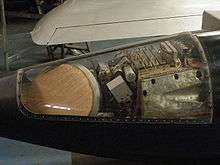
The Mirage IIIE differed from the IIIC interceptor most obviously in having a 300 mm (12 in) forward fuselage extension to increase the size of the avionics bay behind the cockpit. The stretch also helped increase fuel capacity, as the Mirage IIIC had marginal range and improvements were needed. The stretch was small and hard to notice, but the clue is that the bottom edge of the canopy on a Mirage IIIE ends directly above the top lip of the air intake, while on the IIIC it ends behind the lip.
Many Mirage IIIEs (but not all) were fitted with a Marconi continuous-wave Doppler navigation radar radome on the bottom of the fuselage, under the cockpit; no IIICs had this feature. A similar inconsistent variation was the presence or absence of an HF antenna fitted as a forward extension to the vertical tailplane; on some Mirages, the leading edge of the tailplane was a straight line, while on those with the HF antenna the leading edge had a sloping extension forward. The extension appears to have been generally standard on production Mirage IIIAs and Mirage IIICs, but only appeared in some of the Mirage IIIE's export versions. The IIIE featured Thomson-CSF Cyrano II dual mode air / ground radar; a radar warning receiver (RWR) system with the antennas mounted in the vertical tailplane; and an Atar 09C engine, with a petal-style variable exhaust.
The first production Mirage IIIE was delivered to the AdA in January 1964, and a total of 192 were eventually delivered to that service. Total production of the Mirage IIIE, including exports, was substantially larger than that of the Mirage IIIC, including exports, totaling 523 aircraft. In the mid-1960s one Mirage IIIE was fitted with the improved SNECMA Atar 09K-6 turbojet for trials, and given the confusing designation of Mirage IIIC2.
Mirage IIIR
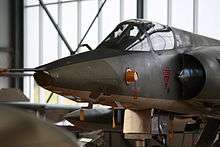
A number of reconnaissance variants were built under the general designation of Mirage IIIR. These aircraft had a Mirage IIIE airframe; Mirage IIIC avionics; a camera nose and unsurprisingly no radar; and retained the twin DEFA cannon and external stores capability. The camera nose accommodated up to five OMERA cameras.
The AdA obtained 50 production Mirage IIIRs, not including two prototypes. The Mirage IIIR preceded the Mirage IIIE in operational introduction. The AdA also obtained 20 improved Mirage IIIRD reconnaissance variants, essentially a Mirage IIIR with an extra panoramic camera in the most forward nose position, and the Doppler radar and other avionics from the Mirage IIIE.
Exports and license production
Exports
The largest export customers for Mirage IIICs built in France were Israel as the Mirage IIICJ and South Africa as the Mirage IIICZ. Some export customers obtained the Mirage IIIB, with designations only changed to provide a country code, such as: Mirage IIIDA for Argentina, Mirage IIIDBR and Mirage IIIDBR-2 for Brazil, Mirage IIIBJ for Israel, Mirage IIIDL for Lebanon, Mirage IIIDP for Pakistan, Mirage IIIBZ and Mirage IIIDZ and Mirage IIID2Z for South Africa, Mirage IIIDE for Spain and Mirage IIIDV for Venezuela.
After the outstanding Israeli success with the Mirage IIIC, scoring kills against Syrian Mikoyan-Gurevich MiG-17s and MiG-21 aircraft and then achieving a formidable victory against Egypt, Jordan, and Syria in the Six-Day War of June 1967, the Mirage III's reputation was greatly enhanced. The "combat-proven" image and low cost made it a popular export success.
The aircraft remained a formidable weapon in the hands of the Pakistan Air Force in No. 5 Squadron, which was fully operational by the 1971 War. Flying out from Sargodha, along with a detachment in Mianwali, these were extensively used for ground attacks. No Mirage was lost in the war. The Mirage fleet is currently being modified to accommodate Aerial Refueling and to carry Hatf-VIII (Ra'ad) cruise missiles. In wake of delays from JF-17 Thunder, aging Mirage IIIs continues to serve in Pakistan Air Force.
A good number of IIIEs were built for export as well, being purchased in small numbers by Argentina as the Mirage IIIEA and Mirage IIIEBR-2 Brazil as the Mirage IIIEBR, Lebanon as the Mirage IIIEL, Pakistan as the Mirage IIIEP, South Africa as the Mirage IIIEZ, Spain as the Mirage IIIEE, and Venezuela as the Mirage IIIEV, with a list of subvariant designations, with minor variations in equipment fit. Dassault believed the customer was always right, and was happy to accommodate changes in equipment fit as customer needs and budget required. Pakistani Mirage 5PA3, for example, were fitted with Thomson-CSF Agave radar with capability of guiding the Exocet anti-ship missile.
Some customers obtained the two-seat Mirage IIIBE under the general designation Mirage IIID, though the trainers were generally similar to the Mirage IIIBE except for minor changes in equipment fit. In some cases they were identical, since two surplus AdA Mirage IIIBEs were sold to Brazil under the designation Mirage IIIBBR, and three were similarly sold to Egypt under the designation Mirage 5SDD. New-build exports of this type included aircraft sold to Abu Dhabi, Argentina, Brazil, Chile, Colombia, Egypt, Gabon, Libya, Pakistan, Peru, Spain, Venezuela, and Zaire.
Export versions of the Mirage IIIR were built for Pakistan as the Mirage IIIRP and South Africa as the Mirage IIIRZ, and Mirage IIIR2Z with an Atar 9K-50 jet engine. Export versions of the IIIR recce aircraft were purchased by Abu Dhabi, Belgium, Colombia, Egypt, Libya, Pakistan, and South Africa. Some export Mirage IIIRDs were fitted with British Vinten cameras, not OMERA cameras. Most of the Belgian aircraft were built locally.
Israel

The Israeli Air Force (IAF) purchased three variants of the Mirage III:[8]
- 70 Mirage IIICJ single-seat fighters, received between April 1962 and July 1964.
- Two Mirage IIIRJ single-seat photo-reconnaissance aircraft, received in March 1964.
- Four Mirage IIIBJ two-seat combat trainers, three received in 1966 and one in 1968.
Israel was forced into updating its own Mirages when France imposed an arms embargo on the region after the 1967 Six Day War. The result was Israel Aircraft Industries' IAI Nesher, based on the Mirage 5. Nevertheless, Mirage IIIB upgrades up to and including a full Kfir-type conversion are also available from IAI.[8]
Pakistan
Pakistan purchased 24 Mirage IIIE from France in 1967.[9] Blue prints of the aircraft designs were given to Pakistan and the Mirage III aircraft are produced under license by the Pakistan Aeronautical Complex awarded since 1990. The total Pakistan Air Force order also included 3 Mirage IIIR and 3 Mirage IIID. An additional 10 Mirage IIIR were delivered in 1977. When French production of the aircraft ceased, Pakistan deferred to Australia and Lebanon, acquiring another 54 Mirage IIIE and 1 Mirage IIIB.[9] These have been modified to accept the Italian made Grifo M-3 radar and Chinese PL-12 air-to-air missiles from the CAC/PAC JF-17 Thunder.[9] |Aircraft Designs
License production
The Mirage IIIE was also built under license in Australia and Switzerland.
Australia
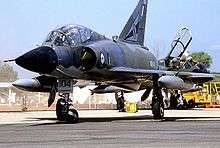
While an experimental Rolls-Royce Avon-powered version did not enter production, the Australian government decided that the Royal Australian Air Force (RAAF) would receive the IIIE, albeit a variant assembled by the Government Aircraft Factories (GAF) in Fishermans Bend, Melbourne from Australian-made components, under the designation Mirage IIIO. The major difference between the IIIE and the IIIO was the avionics installed. The other major Australian aircraft manufacturer at the time, the Commonwealth Aircraft Corporation (CAC), also in Melbourne, built the SNECMA Atar engine.
GAF produced three variants: the Mirage IIIO(F), which was an interceptor, the Mirage IIIO(A), a surface attack aircraft and the twin seat Mirage IIIO(D), a fighter lead-in trainer. Dassault produced two sample IIIO(F) aircraft, with the first flying in March 1963. GAF completed 48 IIIO(F), 50 IIIO(A) and 16 IIIO(D) aircraft.
All the surviving Mirage IIIO(F) aircraft were converted to IIIO(A) standard between 1967 and 1979. The Mirage was finally withdrawn from RAAF service in 1988, and 50 surviving examples were sold to Pakistan in 1990. Several examples are preserved in museums around Australia, and at least one is currently under restoration to airworthy condition.
South Africa
Much like Israel, South Africa was similarly isolated by a French arms embargo after the passage of United Nations Security Council Resolution 418.[10] The South African Air Force launched an ambitious rebuild programme for its Mirage III fleet, soliciting Israeli technical assistance to convert existing airframes into the Atlas Cheetah. Fixed foreplanes distinguish the Cheetah from its Mirage predecessor, and an extended nose, probably inspired by the IAI Kfir, houses a modified electronics suite, including radar.[11]
Built in single-seat, two-seat interceptor, and two-seat combat trainer versions, Atlas Cheetahs entered service in 1987 during the South African Border War. Armament consists of Denel Kukri or Darter heat seeking air-to-air missiles, aided by a pilot's helmet mounted sight.
Switzerland
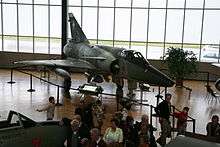
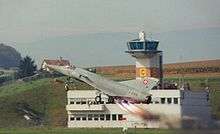
In 1961, Switzerland bought a single Mirage IIIC from France. This Mirage IIIC was used as development aircraft. The Swiss Mirages were built in Switzerland by F+W Emmen (today RUAG, the federal government aircraft factory in Emmen), as the Mirage IIIS. Australia too, bought one French-made aircraft in preparation for licensed production. Cost overruns during the Swiss production led to the so-called "Mirage affair".[12]
In all, 36 Mirage IIIS interceptors were built with strengthened wings, airframe, and undercarriage. The Swiss Air Force required robustness comparable to that of carrier based planes; the airframes were reinforced so the aircraft could be moved by lifting them over other aircraft with a crane, as the aircraft caverns in the mountains that Swiss Air Force uses as bunkers offer very little space to maneuver parked aircraft. The strengthened frames allowed for JATO capability. The main differences to the standard Mirage III were as follows:
- New US avionics with
- Changed cockpit design with gray instead of black panels
- New U.S. radar, TARAN-18 from Hughes Aircraft Company
- Use of HM-55S "Falcon" (Swiss designation of the SAAB Licence built Robot 27 (Rb27) which is similar to the Hughes AIM-26 "Falcon")
- Radar warning receiver (RWR) on both wingtips and on the back of the rudder
- Strengthened structure for use of JATO-Rockets
- Retractable nosecone and lengthened nosewheel leg for storing in Aircraft cavern
- Four lifting points for moving aircraft in underground caverns with a crane
- Bay at the fin with a SEPR 841 rocket engine to double the velocity for short time or climb to 20,000 m (66,000 ft).
- US TRACOR AN/ALE-40 chaff/flare dispenser at the back under the end of the engine (fitted with the upgrade 1988).
- Canards designed and produced by RUAG Aerospace (fitted with the upgrade 1988)
- New Martin-Baker ejection-seat (fitted with the upgrade 1988).
The Swiss Mirages are equipped with RWS, chaff & flare dispensers. Avionics differed as well, with the most prominent difference being that the Thomson-CSF Cyrano II radar was replaced by Hughes TARAN-18 system, giving the Mirage IIIS compatibility with the Hughes AIM-4 Falcon AAM. Also the Mirage IIIS had the wiring to carry a Swiss-built or French nuclear bomb. The Swiss nuclear bomb was stopped in the pre-production stage and Switzerland did not purchase the French-made one. The Mirage IIIS had an integral fuel tank under the aft belly; this fuel tank could be removed and replaced with an adapter of the same shape. This adapter housed a SEPR (Société d'Etudes pour la Propulsion par Réaction) rocket engine with its 300 l (79 US gal; 66 imp gal) nitric acid oxidiser tank. With the SEPR rocket, the Mirage IIIS easily reached altitudes of 24,000 m, an additional thrust of 1500 kp, the SEPR could be switched off and on minimum three times in a flight, a maximum use of 80 seconds was possible. In case of an emergency it was possible to jettison the SEPR Unit in low speed flight. The rocket fuel was very hazardous and highly toxic, so the SEPR rocket was not used very often, special buildings for maintenance were built in Buochs and Payerne and the personnel had to wear special protective suits. The Mirage IIIRS could also carry a photo-reconnaissance centerline pod and an integral fuel tank under the aft belly; this carried a smaller fuel load but allowed a back looking film camera to be added. In the early 1990s, the 30 surviving Swiss Mirage IIIS interceptors were put through an upgrade program, which included fitting them with fixed canards and updated avionics. The Mirage IIIS were phased out of service in 1999. The remaining Mirage IIIRS, BS and DS were taken out of service in 2003.[13]
Operational history

Six Day War
Over the demilitarized zone on the Israeli side of the border with Syria, a total of six MiGs were shot down the first day Mirages fought the MiGs. In the Six-Day War, apart from 12 Mirages (four in the air and eight on the ground) left behind to guard Israel from Arab bombers, all the Mirages were fitted with bombs, and sent to attack the Arab air bases. However the Mirage's performance as a bomber was modest. During the following days Mirages performed as fighters, and out of a total of 58 Arab aircraft shot down in air combat during the war, 48 were accounted for by Mirages.[14]
Yom Kippur War
In the 1973 Yom Kippur War, the Mirage fleet engaged solely in air-to-air operations. ACIG.org claims that at least 26 Mirages and Neshers were lost in air-to-air combat during the war.[15][16][17] Contrary to these claims, formal Israeli sources claim only five Israeli Air Force aircraft were shot down in air-to-air duels.[18] 106 Syrian and Egyptian aircraft were claimed shot down by Israeli Mirage IIICJ planes, and another 140 aircraft were claimed by the Nesher derivative.[14] Giora Epstein, "ace of aces" of modern, supersonic fighter jets and of the Israeli Air Force, won all his victories in Mirage IIICJ and Nesher types.[19]
South African Border War
During the South African Border War, the South African Air Force operated 16 Mirage IIICZ interceptors, 17 Mirage IIIEZ multirole fighter-bombers, and 4 Mirage IIIRZ reconnaissance fighters from bases in South-West Africa.[20] Despite being recognised as an exceptional dogfighter, the Mirage III generally lacked the range to make it effective over long distances during strike operations against People's Liberation Army of Namibia (PLAN) insurgents in Angola.[21] South African pilots also found landing the high-nosed, delta-winged Mirage III airframe difficult on rudimentary airstrips near the operational area.[20]
The Mirage IIIs were eventually assigned to 2 Squadron, SAAF, and restricted to the secondary roles of daytime interception, training exercises, and photographic reconnaissance following the adoption of the Mirage F1. The mediocre performance of the fighter's Cyrano II radar precluded operations at night and during poor weather.[20] By the late 1980s, the Mirage IIICZ was considered so obsolete that it was utilised only for base security.[22] Nevertheless, Mirage IIIRZs continued to be flown in photo reconnaissance missions over Angolan targets, as the only other SAAF aircraft equipped for this role was the more antiquated English Electric Canberra.[21]
SAAF Mirage IIIRZs often flew at extremely low altitudes—sometimes down to fifty feet (15 metres)—then rapidly gained elevation to take their photographs.[22] During the Battle of Cuito Cuanavale they also carried out mock sorties over enemy positions in Xangongo and Humbe in an attempt to lure out Cuban MiG-21s and MiG-23s, which could then be engaged by the superior Mirage F1AZs.[22]
Falklands War
The Argentine Air Force used the Mirage IIIEA during the Falklands War. Their lack of aerial refueling capability dramatically reduced their ability as long-range strike aircraft. Even using two 2000 litre (550 gallon) drop tanks to carry extra fuel, the Mirages (and Daggers) were flying at the absolute limit of their range to reach the British fleet. The fighters sent to engage patrolling Harrier jets and cover a strike force had no more than five minutes over the target area[23] Their usual armament consisted of 1 Matra R530 or 2 Magic 1 AAMs. They only entered combat once, with one being shot down by an AIM-9L Sidewinder and another destroyed by friendly fire after attempting to land at Port Stanley when nearly out of fuel. They were frequently used on diversion flights, flying at very high altitude to force a response from the patrolling Harriers to improve the chances of survival and success of the attack force. Some were also kept on alert against possible Avro Vulcan raids on the mainland and against aggressive Chilean flights on Argentina's western border.[24]
Variants
- M.D.550 Mystere-Delta
- Single-seat delta-wing interceptor-fighter prototype, fitted with a delta vertical tail surface, equipped with a retractable tricycle landing gear, powered by two 7.35 kN (1,650 lbf) thrust M.D.30 (Armstrong Siddeley Viper) turbojet engines; one built.[5]
- Mirage I
- Revised first prototype, fitted with a swept vertical tail surface, powered by two reheated M.D.30R turbojet engines, 9.61 kN (2,160 lbf), also fitted with a 15 kN (3,400 lbf) thrust SEPR 66 rocket booster.[5]
- Mirage II
- Single-seat delta-wing interceptor-fighter prototype, larger version of the Mirage I, powered by two Turbomeca Gabizo turbojet engines; one abandoned incomplete.[5]
- Mirage III-001
- Prototype, initially powered by a 44.12 kN (9,920 lbf) thrust Atar 101G1 turbojet engine, later refitted with 43.15 kN (9,700 lbf) Atar 101G-2 and also fitted with a SEPR 66 auxiliary rocket motor; one built.[5]
- Mirage IIIA
- Pre-production aircraft, with a lengthened, area ruled fuselage and powered by a 42.8 kN (9,600 lbf) dry and 58.84 kN (13,230 lbf) with reheat Atar 9B turbojet engine, also with provision for 13.34 kN (3,000 lbf) SEPR 84 auxiliary rocket motor. Fitted with Dassault Super Aida or Thomson-CSF Cyrano Ibis radar. Ten built for the French Air Force.[25]

- Mirage IIIB
- Two-seat tandem trainer aircraft fitted with one piece canopy. Lacks radar, cannon armament and provision for booster rocket. Prototype (based on the IIIA) first flown on 20 October 1959. Followed by 26 production IIIBs based on IIIC for French Air Force and one for Centre d'essais en vol (CEV) test centre.[26][27]
- Mirage IIIB-1 : Trials aircraft. Five built.[27]
- Mirage IIIB-2(RV) : Inflight refuelling training aircraft for Mirage IV force, fitted with dummy refuelling probe in nose. Ten built.[28]
- Mirage IIIBE : Two-seat training aircraft based on Mirage IIIE for the French Air Force, similar to the Mirage IIID. 20 built.[28]
- Mirage IIIBJ : Mirage IIIB for Israeli Air Force. Five built.[27]
- Mirage IIIBL : Mirage IIIBE for Lebanon Air Force.[28]
- Mirage IIIBS : Mirage IIIB for the Swiss Air Force; four built.[27]
- Mirage IIIBZ : Mirage IIIB for the South African Air Force; three built.[27]
- Mirage IIIC
- Single-seat all-weather interceptor-fighter aircraft, with longer fuselage than the IIIA (14.73 m (48.3 ft)) and equipped with a Cyrano Ibis radar. The Mirage IIIC was armed with two 30 mm (1.181 in) cannon, with a single Matra R.511, Nord AA.20 or Matra R530 air-to-air missile under the fuselage and two AIM-9 Sidewinder missiles under the wings. It was powered by an Atar 9B-3 turbojet engine, which could be supplemented by fitting an auxiliary rocket motor in the rear fuselage if the cannon were removed. 95 were built for the French Air Force.[29]
- Mirage IIICJ : Mirage IIIC for the Israeli Air Force, fitted with simpler electronics and with provision for the booster rocket removed.[30] 72 delivered between 1961 and 1964.[31]
- Mirage IIICS : Mirage IIIC supplied to Swiss Air Force in 1962 for evaluation and test purposes. One built.[31]
- Mirage IIICZ : Mirage IIIC for the South African Air Force. 16 supplied between December 1962 and March 1964.[32]
- Mirage IIIC-2 : Conversion of French Mirage IIIE with Atar 09K-6 engine. One aircraft converted, later re-converted to Mirage IIIE.[27]
- Mirage IIID
- Two-seat trainer version of the Mirage IIIE, powered by 41.97 kN (9,440 lbf) dry and 58.84 kN (13,230 lbf) with reheat Atar 09-C engine. Fitted with distinctive strakes under the nose. Almost identical aircraft designated Mirage IIIBE, IIID and 5Dx depending on customer.[33]
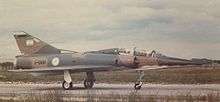
- Mirage IIID : Two-seat training aircraft for the RAAF. Built under licence in Australia; 16 built.[34]
- Mirage IIIDA : Two-seat trainer for the Argentine Air Force. Two supplied 1973 and a further two in 1982.[34][35]
- Mirage IIIDBR : Two-seat trainer for the Brazilian Air Force, designated F-103D. Four newly built aircraft delivered from 1972. Two ex-French Air Force Mirage IIIBEs delivered 1984 to make up for losses in accidents.[36]
- Mirage IIIDBR-2 : Refurbished and updated aircraft for the Brazilian Air Force, with more modern avionics and canard foreplanes. Two ex-French aircraft sold to Brazil in 1988, with remaining two DBRs upgraded to same standard.[37]
- Mirage IIIDE : Two-seat trainer for Spanish Air Force. Six built with local designation CE.11.[38]
- Mirage IIIDP : Two-seat trainer for the Pakistan Air Force. Five built.[39]
- Mirage IIIDS : Two-seat trainer for the Swiss Air Force. Two delivered 1983.[40]
- Mirage IIIDV : Two-seat trainer for the Venezuelan Air Force; three built.[34]
- Mirage IIIDZ : Two-seat trainer for the South African Air Force; three delivered 1969.[32]
- Mirage IIID2Z : Two-seat trainer for the South African Air Force, fitted with an Atar 9K-50 turbojet engine; giving 49.2 kN (11,100 lbf) thrust dry and 70.6 kN (15,900 lbf) with reheat. Eleven built.[41][42]

- Mirage IIIE
- Single-seat tactical strike and fighter-bomber aircraft, with 300 mm (12 in) fuselage plug to accommodate an additional avionics bay behind the cockpit. Fitted with Cyrano II radar with additional air-to-ground modes compared to Mirage IIIC, improved navigation equipment, including TACAN and a Doppler radar in undernose bulge. Powered by an Atar 09C-3 turbojet engine.[43] 183 built for the French Air Force.[44]
- Mirage IIIEA : Mirage IIIE for the Argentine Air Force. 17 built.[35]
- Mirage IIIEBR : Mirage IIIE for the Brazilian Air Force; 16 built, locally designated F-103E.[37]
- Mirage IIIEBR-2 : Refurbished and updated aircraft for the Brazilian Air Force, with canard foreplanes. Four ex-French aircraft sold to Brazil in 1988, with surviving Mirage IIIEBRs upgraded to same standard.[37]
- Mirage IIIEE : Mirage IIIE for the Spanish Air Force, locally designated C.11. 24 delivered from 1970.[45]
- Mirage IIIEL : Mirage IIIE for the Lebanese Air Force, omitting doppler radar, including HF antenna. 10 delivered from 1967 and 1969.[46][47]
- Mirage IIIEP : Mirage IIIE for the Pakistan Air Force. 18 delivered 1967–1969.[39]
- Mirage IIIEV : Mirage IIIE for the Venezuelan Air Force, omitting doppler radar. Seven built. Survivors upgraded to Mirage 50EV standard.[48]
- Mirage IIIEZ : Mirage IIIE for the South African Air Force; 17 delivered 1965–1972.[32]
- Mirage IIIO
- Single-seat all-weather fighter-bomber aircraft for the Royal Australian Air Force. Single prototype powered by 53.68 kN (12,070 lbf) dry thrust and 71.17 kN (16,000 lbf) Rolls-Royce Avon Mk.67 turbojet engine, but order placed for aircraft based on Mirage IIIE, powered by Atar engine in March 1961. 100 aircraft built, of which 98 were built under licence in Australia. The first 49 were Mirage IIIO(F) interceptors which were followed by 51 Mirage IIIO(A) fighter bombers, with survivors brought up to a common standard later.[49]

- Mirage IIIR
- Single-seat all-weather reconnaissance aircraft, with radar replaced by camera nose carrying up to five cameras. Aircraft based on IIIE airframe but with simpler avionics similar to that fitted to the IIIC and retaining cannon armament of fighters. Two prototypes and 50 production aircraft built for the French Air Force.[50][51]
- Mirage IIIRD : Single-seat all-weather reconnaissance aircraft for the French Air Force, equipped with improved avionics, including undernose doppler radar as in the Mirage IIIE. Provision to carry infrared linescan, Doppler navigation radar or side looking airborne radar (SLAR) in interchangeable pod. 20 built.[50][51]
- Mirage IIIRJ : Single-seat all-weather econniassance aircraft of the Israeli Air Force. Two Mirage IIICZs converted into reconnaissance aircraft.
- Mirage IIIRP : Export version of the Mirage IIIR for the Pakistan Air Force; 13 built.
- Mirage IIIRS : Export version of the Mirage IIIR for the Swiss Air Force; 18 built.
- Mirage IIIRZ : Export version of the Mirage IIIR for the South African Air Force; four built.
- Mirage IIIR2Z : Export version of the Mirage IIIR for the South African Air Force, fitted with an Atar 9K-50 turbojet engine; four built.

- Mirage IIIS
- Single-seat all-weather interceptor fighter aircraft for the Swiss Air Force, based on the IIIC, but fitted with a Hughes TARAN 18 radar and fire-control system and armed with AIM-4 Falcon and Sidewinder air-to-air missiles. Built under licence in Switzerland; 36 built.
- Mirage IIIT
- One aircraft converted into an engine testbed, fitted with a 88.29 kN (19,850 lbf) Pratt & Whitney/SNECMA TF106 turbofan engine.
- Mirage IIIX
- Proposed version, announced in 1982, fitted with updated avionics and fly-by-wire controls, powered by an Atar 9K-50 turbojet engine. Original designation of the Mirage 3NG.
Derivatives
Mirage 5/Mirage 50
The next major variant, the Mirage 5, grew out of a request to Dassault from the Israeli Air Force. The first Mirage 5 flew on 19 May 1967. It looked much like the Mirage III, except it had a long slender nose that extended the aircraft's length by about half a meter. The Mirage 5 itself led directly to the Israeli Nesher, either through a Mossad (Israeli intelligence) intelligence operation or through covert cooperation with AdA, depending upon which story is accepted. (See details in the Nesher article). In either case, the design gave rise to the Kfir, which can be considered a direct descendant of the Mirage III.
Milan
In 1968, Dassault, in cooperation with the Swiss, began work on a Mirage update known as the Milan ("Kite"). The main feature of the Milan was a pair of pop out foreplanes in the nose, which were referred to as "moustaches". The moustaches were intended to provide better take-off performance and low-speed control for the attack role. The three initial prototypes were converted from existing Mirage fighters; one of these prototypes was nicknamed "Asterix", after the internationally popular French cartoon character, a tough little Gallic warrior with a huge moustache.
A fully equipped prototype rebuilt from a Mirage IIIR flew in May 1970, and was powered by the uprated 70.6 kN (15,900 lbf) afterburning thrust SNECMA Atar 09K-50 engine, following the evaluation of an earlier model of this new series on the one-off Mirage IIIC2. The Milan also had updated avionics, including a laser designator and rangefinder in the nose. A second fully equipped prototype was produced for Swiss evaluation as the Milan S.
The canards did provide significant handling benefits, but they had drawbacks. They blocked the pilot's forward view to an extent, and set up turbulence in the engine intakes. The Milan concept was abandoned in 1972, while work continued on achieving the same goals with canards.
Mirage 3NG
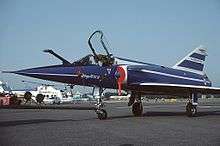
Following the development of the Mirage 50, Dassault had experimented with yet another derivative of the original Mirage series, named the Mirage 3NG (Nouvelle Génération, new generation). Like the Milan and Mirage 50, the 3NG was powered by the Atar 9K-50 engine. The prototype, a conversion of a Mirage IIIR, flew in December 1982.
The 3NG had a modified delta wing with leading-edge root extensions, plus a pair of fixed canards fitted above and behind the air intakes. The canards provided a degree of turbulent airflow over the wing to make the aircraft more unstable and so more maneuverable.
Avionics were completely modernized, using off the development effort for the next-generation Mirage 2000 fighter. The Mirage 3NG used a fly-by-wire system to allow control over the aircraft's instabilities, and featured an advanced nav/attack system; new multimode radar; and a laser rangefinder system. The uprated engine and aerodynamics gave the Mirage 3NG impressive performance. The type never went into production, but to an extent the 3NG was a demonstrator for various technologies that could be and were featured in upgrades to existing Mirage IIIs and Mirage Vs.
After 1989, enhancements derived from the 3NG were incorporated into Brazilian Mirage IIIEs, as well as into four ex-Armée de l'Air Mirage IIIEs that were transferred to Brazil in 1988. In 1989, Dassault offered a similar upgrade refit of ex-AdA Mirage IIIEs under the designation Mirage IIIEX, featuring canards, a fixed in-flight refueling probe, a longer nose, new avionics, and other refinements.
A total of 1,422 Mirage III/5/50 aircraft of all types were built by Dassault. There were a few unbuilt variants:
- A Mirage IIIK that was powered by a Rolls-Royce Spey turbofan was offered to the British Royal Air Force.
- The Mirage IIIM was a carrier-based variant, with catapult spool and arresting hook, for operation with the French Aéronavale.
- The Mirage IIIW was a lightweight fighter version, proposed for a US competition, with Dassault partnered with Boeing. The aircraft would have been produced by Boeing, but it lost to the Northrop F-5 Freedom Fighter.
Balzac / Mirage IIIV
One of the offshoots of the Mirage III/5/50 fighter family tree was the Mirage IIIV vertical take-off and landing (VTOL) fighter. ("IIIV" is read "three-vee," not "three-five"). This aircraft featured eight small vertical lift jets straddling the main engine. The Mirage IIIV was built in response to a mid-1960s NATO specification for a VTOL strike fighter. Mirage IIIV carries eight RB.162-31 lift engines(generating 5,400 lb thrust each), long-stroke landing gears, and additional covers to reduce impact of the lift engine exhausts. Main engine a SNECMA TF-104 turbojet.[52]
Mirage III ROSE
Project ROSE (Retrofit Of Strike Element) was an upgrade programme launched by the Pakistan Air Force to upgrade old Dassault Mirage III and Mirage 5 aircraft with modern avionics. In the early 1990s, the PAF procured 50 ex-Australian Mirage III fighters, 33 of which were selected after an inspection to undergo upgrades. In the first phases of Project ROSE, the ex-Australian Mirage III fighters were fitted with new defensive systems and cockpits, which included new HUDs, MFDs, RWRs, HOTAS controls, radar altimeters and navigation/attack systems. They were also fitted with the FIAR Grifo M3 multi-mode radar and designated ROSE I. Around 34 Mirage 5 attack fighters also underwent upgrades designated ROSE II and ROSE III before Project ROSE was completed. The Mirage III/5 ROSE fighters are expected to remain in service with the PAF until replacement in the mid-2010s.
Operators

Military operators
Current
Former
 France: 348[4]
France: 348[4] Argentina: 21[9]
Argentina: 21[9] Australia: 110[9]
Australia: 110[9] Brazil: 27[9]
Brazil: 27[9] Chile: 1[9]
Chile: 1[9] Spain: 30[9]
Spain: 30[9] Israel: 76[9]
Israel: 76[9] Lebanon: 12[9]
Lebanon: 12[9].svg.png) South Africa: 58[9]
South Africa: 58[9] Switzerland: 60[9]
Switzerland: 60[9] Abu Dhabi: 18[53]
Abu Dhabi: 18[53] Venezuela: 9[9]
Venezuela: 9[9]
Civilian operators
- Espace Passion Foundation operates a single Mirage III-DS (S/N 101/228F) civil registration HB-RDF[54]
Specifications (Mirage IIIE)
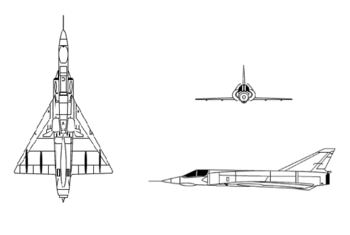
Data from Encyclopedia of World Military Aircraft[55]
General characteristics
- Crew: 1
- Length: 15.03 m (49 ft 4 in)
- Wingspan: 8.22 m (27 ft 0 in)
- Height: 4.5 m (14 ft 9 in)
- Wing area: 34.85 m2 (375.1 sq ft)
- Empty weight: 7,050 kg (15,543 lb)
- Gross weight: 9,600 kg (21,164 lb)
- Max takeoff weight: 13,700 kg (30,203 lb)
- Powerplant: 1 × SNECMA Atar 09C afterburning turbojet engine, 41.97 kN (9,440 lbf) thrust dry, 60.8 kN (13,700 lbf) with afterburner
- Powerplant: 1 × SEPR 841 liquid-fuelled rocket engine, 14.7 kN (3,300 lbf) thrust
Performance
- Maximum speed: 2,350 km/h (1,460 mph; 1,269 kn) at 12,000 m (39,000 ft)
- Maximum speed: Mach 2
- Combat range: 1,200 km (746 mi; 648 nmi)
- Ferry range: 3,335 km (2,072 mi; 1,801 nmi)
- Service ceiling: 17,000 m (55,774 ft)
- Rate of climb: 237 m/s (46,600 ft/min)
Armament
- Guns: 2× 30 mm (1.181 in) DEFA 552 cannon with 125 rounds per gun
- Rockets: 2× Matra JL-100 drop tank/rocket pack, each with 19× 68 mm (2.7 in) SNEB rockets and 250 l (66 US gal; 55 imp gal) of fuel
- Missiles: 2× AIM-9 Sidewinder Air to Air missiles (AAM)
- 2x Matra R.550 Magic AAMs plus 1× Matra R.530 AAM
- Bombs: 4,000 kg (8,800 lb) of payload on five external hardpoints, including a variety of bombs, reconnaissance pods or Drop tanks; French Air Force IIIEs through to 1991 were equipped to carry the AN-52 nuclear bomb.
Avionics
Thomson-CSF Cyrano II radar; Marconi continuous-wave Doppler navigation radar
See also
- Related development
- Atlas Cheetah
- Dassault Mirage IV
- Dassault Mirage 5
- Dassault Mirage IIIV
- Dassault Mirage 2000
- IAI Kfir
- Aircraft of comparable role, configuration and era
- Convair F-102 Delta Dagger
- Convair F-106 Delta Dart
- Mikoyan-Gurevich MiG-21/Chengdu J-7
- Saab 35 Draken
- Related lists
Record setting pilots
References
Notes
- 1 2 Brindley, John. Aircraft Profile Vol 1 230. Dassault Mirage variants (Windsor, Berks: Profile Publications).
- ↑ Duchateau, Philippe & Huertas, Salvador Mafe. Mirage! Dassault's Mach 2 Warriors. Osprey Publishing 1990. ISBN 0-85045-953-2 pp 1–7.
- ↑ Wheeler 1992, p. 117.
- 1 2 3 4 5 6 Dassault Aviation Mirage III
- 1 2 3 4 5 6 7 Jackson World Air Power Journal Volume 14, p. 120.
- 1 2 Jackson 1985, p. 12.
- ↑ "no title" (PDF). S.E.P.R. Union Revue d'Information du Personnel (in French) (4): 34. February 1959. Retrieved 26 October 2014.
- 1 2 "Dassault Mirage III & Mirage 5/Nesher in Israeli Service". ACIG. 2003. Retrieved 2013-08-09.
- 1 2 3 4 5 6 7 8 9 10 11 12 13 14 "Trade Registers". Armstrade.sipri.org. Retrieved 2014-12-03.
- ↑ Jacklyn Cock, Laurie Nathan (1989). War and Society: The Militarisation of South Africa. New Africa Books. ISBN 978-0-86486-115-3.
- ↑ Polakow-Suransky, Sasha. The Unspoken Alliance: Israel's Secret Relationship with Apartheid South Africa. pp. 1–336.
- ↑ François Modoux, « Du Mirage au Gripen : l'épreuve du carcan financier », Le Temps, Thursday 15 May 2014, p. 9.
- ↑ "Historical aircraft." Swiss Air Force. Retrieved 9 April 2010.
- 1 2 Šafařík, Jan J. "Attributed Israeli Air Combat Victories". Air Aces. Retrieved 28 December 2013.
- ↑ "Egyptian Air-to-Air Victories since 1948." ACIG. Retrieved: 25 August 2013.
- ↑ "Syrian Air-to-Air Victories since 1948." ACIG. Retrieved: 25 August 2013.
- ↑ "Iraqi Air-to-Air Victories since 1967."ACIG. Retrieved: 25 August 2013.
- ↑ "Downing". Israeli Air Force official site. Retrieved 2013-12-28.
- ↑ "The Best Pilot". Amazing Airplanes. Retrieved 28 December 2013.
- 1 2 3 Lord, Dick (2008). Vlamgat: The Story of the Mirage F1 in the South African Air Force. Johannesburg, South Africa: 30° South Publishers. ISBN 1-920143-36-X.
- 1 2 Lord, Dick (2012). From Fledgling to Eagle. The South African Air Force during the Border War. Solihull, West Midlands, UK: Helion and Company Ltd. ISBN 9781908916624.
- 1 2 3 Scholtz, Leopold (2013). The SADF in the Border War 1966–1989. Cape Town: Tafelberg. ISBN 978-0-624-05410-8.
- ↑ Argentine Airpower in the Falklands War
- ↑ HALCONES SOBRE MALVINAS, ISBN 950-9294-07-1
- ↑ Jackson World Air Power Journal Volume 14, pp. 121–122.
- ↑ Jackson World Air Power Journal Volume 14, p. 122.
- 1 2 3 4 5 6 Jackson World Air Power Journal Volume 14, p. 124.
- 1 2 3 Jackson World Air Power Journal Volume 14, p. 125.
- ↑ Jackson World Air Power Journal Volume 14, p. 122–123.
- ↑ Jackson World Air Power Journal Volume 16, p. 108.
- 1 2 Jackson World Air Power Journal Volume 14, p. 123.
- 1 2 3 Jackson World Air Power Journal Volume 16, p. 113.
- ↑ Jackson World Air Power Journal Volume 14, pp. 125–126.
- 1 2 3 Jackson World Air Power Journal Volume 14, p. 126.
- 1 2 Jackson World Air Power Journal Volume 16, p. 91.
- ↑ Jackson 1985, pp. 49–50.
- 1 2 3 Jackson World Air Power Journal Volume 16, p. 96.
- ↑ Jackson World Air Power Journal Volume 16, p. 114.
- 1 2 Jackson World Air Power Journal Volume 16, p. 111.
- ↑ Jackson 1985, p. 56.
- ↑ Jackson 1985, pp. 54–55.
- ↑ Jackson World Air Power Journal Volume 15, p. 103.
- ↑ Jackson World Air Power Journal Volume 14, pp. 126–127.
- ↑ Jackson World Air Power Journal Volume 16, p. 98.
- ↑ Jackson 1985, pp. 55–56.
- ↑ Jackson World Air Power Journal Volume 14, p. 127.
- ↑ Jackson 1985, p. 53.
- ↑ Jackson World Air Power Journal Volume 16, p. 116.
- ↑ Jackson World Air Power Journal Volume 14, p. 132.
- 1 2 Jackson World Air Power Journal Volume 14, pp. 132–133.
- 1 2 Jackson 1985, pp. 25, 27.
- ↑ "Mirage III fighter jet family, AirForceWorld.com". Retrieved 2013-08-26.
- ↑ Kolodziej, Edward A. "Making and Marketing Arms: The French Experience and Its Implications for the International System." Princeton University Press, 2014. ISBN 1-40085-877-1. pp 347–350.
- ↑ "Swiss Aircraft Registry". Retrieved 29 August 2012.
- ↑ Donald and Lake 1996, p. 125.
Bibliography
- Atlejees, Leephy. Armscor Film by Armscor, SABC and Leephy Atlejees. Public broadcast by SABC Television, 1972, rebroadcast: 1982, 1984.
- Baker, Nigel and Tom Cooper. "Middle East Database: Dassault Mirage III & Mirage 5/Nesher in Israeli Service". www.acig.org, Air Combat Information Group Journal (ACIG), 26 September 2003. Retrieved: 1 March 2009.
- Breffort, Dominique and Andre Jouineau. "The Mirage III, 5, 50 and derivatives from 1955 to 2000." Planes and Pilots 6. Paris: Histoire et Collections, 2004. ISBN 2-913903-92-4.
- "Cheetah: Fighter Technologies". Archimedes 12. June 1987.
- Cooper, Tom. "Middle East Database: War of Attrition, 1969–1970." www.acig.org, Air Combat Information Group Journal (ACIG), 24 September 2003. Retrieved: 1 March 2009.
- "The Designer of the B-1 Bomber's Airframe". Wings Magazine, Vol. 30/No 4, August 2000, p. 48.
- Donald, David and Jon Lake, eds. Encyclopedia of World Military Aircraft. Westport, Connecticut, USA: AIRtime Publishing, 1996. ISBN 1-880588-24-2.
- Eden, Paul (ed.). The Encyclopedia of Modern Military Aircraft. London: Amber Books, 2004. ISBN 1-904687-84-9.
- Green, William and Gordon Swanborough. The Complete Book of Fighters. New York: Smithmark Books, 1994, ISBN 0-8317-3939-8.
- Jackson, Paul. "Mirage III/5/50 Variant Briefing: Part 1: Dassault's Delta". World Air Power Journal Volume 14, Autumn/Fall 1993, pp. 112–137. London: Aerospace Publishing. ISBN 1-874023-32-8. ISSN 0959-7050.
- Jackson, Paul. "Mirage III/5/50 Variant Briefing: Part 2: Fives, Fifties, Foreigners and Facelifts". World Air Power Journal Volume 15, Winter 1993, pp. 100–119. London:Aerospace Publishing. ISBN 1-874023-34-4. ISSN 0959-7050.
- Jackson, Paul. "Mirage III/5/50 Variant Briefing: Part 3: The Operators". World Air Power Journal Volume 16, Spring 1994, pp. 90–119. London: Aerospace Publishing. ISBN 1-874023-36-0. ISSN 0959-7050.
- Jackson, Paul. Modern Combat Aircraft 23: Mirage. Shepperton, UK: Ian Allen, 1985. ISBN 0-7110-1512-0.
- Lake, Jon. "Atlas Cheetah". World Air Power Journal 27, Winter 1966. pp. 42–53.
- Lake, Jon. "Atlas Cheetah". World Air Power Journal 27: 42–53, Winter 1966.
- Pérez San Emeterio, Carlos. Mirage: Espejismo de la técnica y de la política (in Spanish). Madrid: Armas 30. Editorial San Martin, 1978. ISBN 84-7140-158-4.
- Rogers, Mike. VTOL Military Research Aircraft. London: Foulis, 1989. ISBN 0-85429-675-1.
- Schürmann, Roman. Helvetische Jäger. Dramen und Skandale am Militärhimmel (in German). Zürich: Rotpunktverlag, 2009. ISBN 978-3-85869-406-5.
- Wheeler, Barry C. The Hamlyn Guide to Military Aircraft Markings. London: Chancellor Press, 1992. ISBN 1-85152-582-3.
The initial version of this article was based on a public domain article from Greg Goebel's Vectorsite.
Further reading
- Núñez Padin, Jorge Felix (2013). Núñez Padin, Jorge Felix, ed. Dassault Mirage IIICJ/BJ & EA/DA. Serie Fuerza Aérea (in Spanish). 23. Bahía Blanca, Argentina: Fuerzas Aeronavales. ISBN 978-987-1682-21-8. Retrieved 2014-08-24.
External links
| Wikimedia Commons has media related to Dassault Mirage III. |
- Mirage-III MRO at Pakistan Aeronautical Complex (PAC)
- The History of the Dassault Mirage III in Brazil (with pictures) – Milavia.net
- The Dassault Mirage III/5/50 Series from Greg Goebel's AIR VECTORS
- Mirage III/5/50 at FAS.org
- Mirage Argentina, el sitio de los Deltas argentinos – details, side views, and pictures of Argentine mirages (in Spanish). Retrieved: 17 May 2008,
- Official Page of the Swiss Air Force in German (more detailed than English version)
- Mirage III fighter jet family, AirForceWorld.com